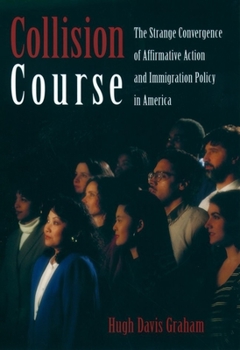Collision Course: The Strange Convergence of Affirmative Action and Immigration Policy in America
Select Format
Select Condition 
Book Overview
When the Civil Rights Act of 1964 and the Immigration and Naturalization Act of 1965 were passed, they were seen as triumphs of liberal reform applauded by the majority of Americans. But today, as Hugh Graham shows in Collision Course, affirmative action is foundering in the great waves of immigration from Asia and Latin America, leading to direct conflict for jobs, housing, education, and government preference programs.
How did two such well-intended laws come to loggerheads? Graham argues that a sea change occurred in American political life in the late 1960s, when a system of split government--one party holding the White House, the other holding Congress--divided authority and enhanced the ability of interest groups to win expanded benefits. In civil rights, this led to a shift from nondiscrimination to the race-conscious remedies of hard affirmative action. In immigration, it led to a surge that by 2000 had brought 35 million immigrants to America, 26 million of them Asian or Latin American and therefore eligible, as "official minorities," for affirmative action preferences. The policies collided when employers, acting under affirmative action plans, hired millions of immigrants while leaving high unemployment among inner-city blacks. Affirmative action for immigrants stirred wide resentment and drew new attention to policy contradictions. Graham sees a troubled future for both programs. As the economy weakens and antiterrorist border controls tighten, the competition for jobs will intensify pressure on affirmative action and invite new restrictions on immigration.
Graham's insightful interpretation of the unintended consequences of these policies is original and controversial. A short, focused, and even-handed narrative, it illuminates many of the issues that vex the United States today.
How did two such well-intended laws come to loggerheads? Graham argues that a sea change occurred in American political life in the late 1960s, when a system of split government--one party holding the White House, the other holding Congress--divided authority and enhanced the ability of interest groups to win expanded benefits. In civil rights, this led to a shift from nondiscrimination to the race-conscious remedies of hard affirmative action. In immigration, it led to a surge that by 2000 had brought 35 million immigrants to America, 26 million of them Asian or Latin American and therefore eligible, as "official minorities," for affirmative action preferences. The policies collided when employers, acting under affirmative action plans, hired millions of immigrants while leaving high unemployment among inner-city blacks. Affirmative action for immigrants stirred wide resentment and drew new attention to policy contradictions. Graham sees a troubled future for both programs. As the economy weakens and antiterrorist border controls tighten, the competition for jobs will intensify pressure on affirmative action and invite new restrictions on immigration.
Graham's insightful interpretation of the unintended consequences of these policies is original and controversial. A short, focused, and even-handed narrative, it illuminates many of the issues that vex the United States today.
Format:Hardcover
Language:English
ISBN:0195143183
ISBN13:9780195143188
Release Date:April 2002
Publisher:Oxford University Press, USA
Length:256 Pages
Weight:1.18 lbs.
Dimensions:1.0" x 6.0" x 9.3"
Customer Reviews
1 rating
Outstanding history, frightening future
Published by Thriftbooks.com User , 22 years ago
Graham was a distinguished historian and political scientist at Vanderbilt and UC Santa Barbara. Sadly, he died just as it was time to go do a book tour in promotion of Collision Course, so the book got little publicity. As an expert on Congress and the workings of the federal bureaucracy, he is able to recreate just how we managed to stumble unintentionally into the current, highly contradictory, immigration and affirmative action systems. At a time when the nation was finally intending to help African-Americans, why did it suddenly import tens of millions of low wage workers to drive blacks from many workplaces? And if affirmative action was intended as compensation for slavery and Jim Crow, why was it extended to new immigrants, even illegal ones? And what does this portend for the future, when the "racial ratio" of beneficiaries from quotas compared to those who must shoulder the burden mounts ever higher?





